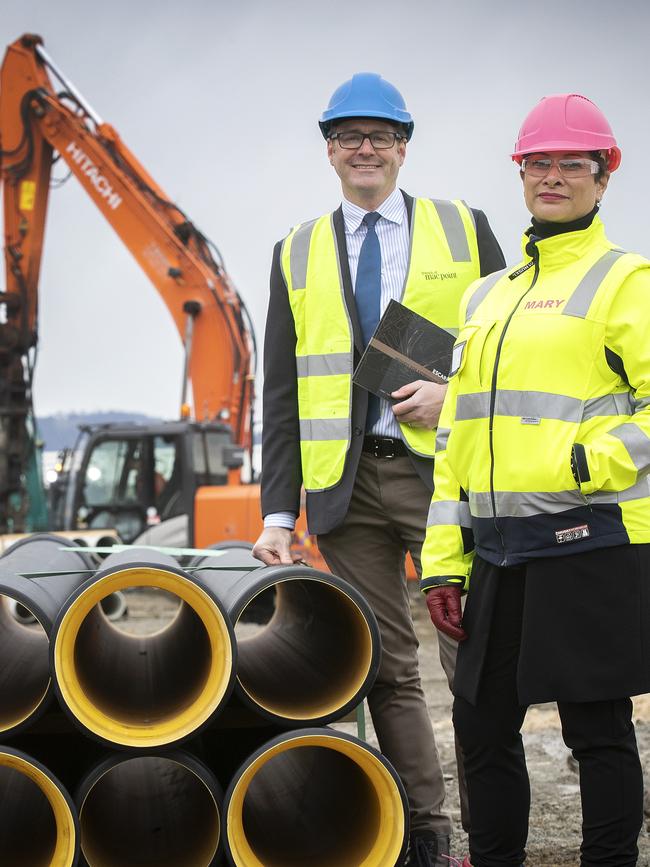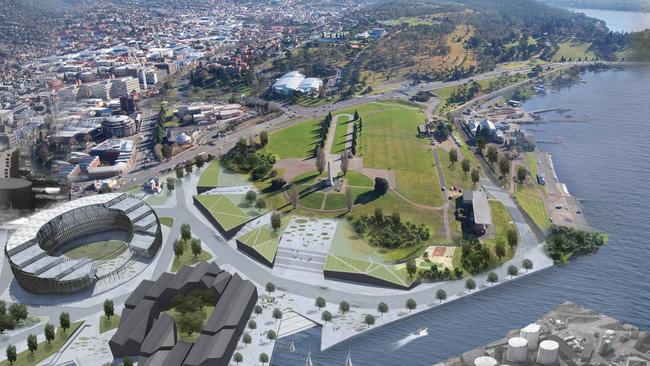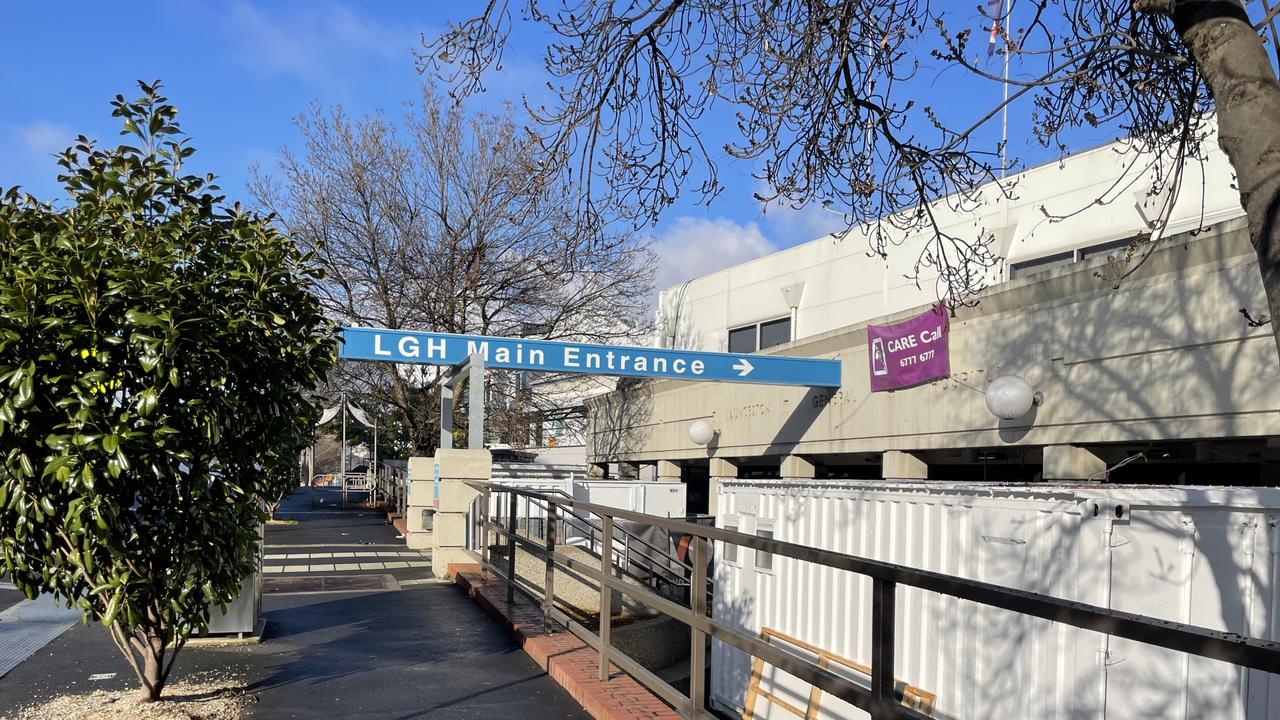Mary Massina has said little since leaving the MPDC in July
The state government’s plan for a stadium at Macquarie Point has destroyed any chance of private investment flowing to the site, former CEO Mary Massina says. HER SAY >>
Tasmania
Don't miss out on the headlines from Tasmania. Followed categories will be added to My News.
The state government’s plan for a stadium at Macquarie Point has destroyed any chance of private investment flowing to the site, the former CEO says.
In an opinion piece for the Mercury, former Macquarie Point Development Corporation (MPDC) chief executive Mary Massina has said the state government has bungled the project.
“Regardless of the outcome of the funding ask of the Federal Government of 50 per cent of today’s construction cost of a stadium, the site is burnt from a private investment perspective. The 18 small business tenants are faced with uncertainty and Tasmanians are faced with yet another development argument which just cements the belief that no large-scale development can occur here,” Ms Massina said.
Ms Massina left the MPDC in July.

Her departure followed an investigation into allegations of bullying at the corporation and criticism around a lack of progress at the site.
Ms Massina also defended progress at Macquarie Point during her tenure.
This included the majority of remediation being completed, the construction of roading, the first parcel of land being put up for sale, a business case for the Antarctic and Science Precinct and work with the Tasmanian Aboriginal community for a Truth and Reconciliation Art Park.

Minister for State Development, Construction and Housing Guy Barnett said while Ms Massina was entitled to defend her record, the state government was focused on the future.
“Before us now we have a once in a generation opportunity to make the right decision for the site and embark on the type of development that has successfully transformed cities and economies across Australia and indeed the world,” Mr Barnett said.
“An arts, entertainment and sporting precinct at Macquarie Point is exactly the sort of project our state needs to keep our economy strong and enrich the lives of Tasmanians, with events being able to come to our State on a scale never before possible.
“The vision for the boutique precinct is to complement the Hobart waterfront, co-existing with the proposed Antarctic and Science precinct which the Government remains firmly committed to, as well as the reconciliation park intention, in consultation with the Tasmanian Aboriginal Community.”
Mr Barnett said and independent PricewaterhouseCoopers report showed the precinct would inject $300 million into the local economy through construction, support 4200 jobs,
inject $85 million annually and support 950 jobs once operational.
Make a point to ensure project doesn’t become a costly missed opportunity
By Mary Massina
FIVE years ago, I was asked by then state growth minister Peter Gutwein to take on Macquarie Point, which had been mired in controversy.
A challenging job with little or no support beyond that of former premier Gutwein and minister Ferguson; a development that has had four responsible ministers in five years, and had gone through three state elections and two federal elections.
I will be the first person to say that governments can change their minds about a development they own.
But in my opinion, with the decision to ditch the agreed masterplan and instead seek to place an AFL stadium on this site, the government has squandered an opportunity at Macquarie Point to develop a superb future-proofed site that is a place for all, acknowledges its bloody past, its present, and firmly and proudly faces the future.

Just as the site was poised to emerge from Covid lockdowns with nearly $1bn in investment locked in, we get a third masterplan, more delays, a requirement for an unlikely $375m from the federal government – but no changes to a messy governance structure.
With every masterplan, you are effectively starting all over again. So, when I started in early 2017, we revised all of the technical reports covering infrastructure, remediation, economic, planning, sustainability and stakeholder management – in this case 980 pages of reports. We also needed to convince the Tasmanian Planning Commission to change its 2016 ruling, which saw the waste water treatment plant effectively make all development on site cost-prohibitive – halting interim and permanent development.
Once the masterplan was drafted and the subsequent redrafting of the planning rules for development and use, Clause 32 of the Sullivans Cove Planning Scheme 1997, the site required all the other machinery of development to be resolved.
Until 2018, the Macquarie Point Development Corporation did not even own the land it was on, and for any development to occur it required the approval of the Department of State Growth – a turgid process.
Next, the governing legislation focused solely on remediation and needed a new Bill through both houses of parliament, which occurred in late 2018.
Only then, in early 2019, could Mac Point finally submit its masterplan and draft planning rules to the Hobart City Council for public commentary and approval, before moving on to the Tasmanian Planning Commission for another round of public representation and approval.
So, some nine years after initial funding, in October 2019, the site finally received its approved planning rules and masterplan and for the first time could start what it was originally funded for, remediation.
Concurrent with this, approval was sought for a road that would allow for the development to finally occur on site, only to stare down the surprise intervention by the former Glenorchy City Council mayor, who wished to stop development on the site due to her support of the light rail concept.
Then Covid hit the world.
Since 2017, the activation of the site had seen it opened to the public, with hundreds of thousands of people visiting each year and some 20 tenants on site generating an income to help offset the corporation’s operating costs.

In 2020, Mac Point was the first government entity to provide support packages to keep these small businesses alive during Covid.
Despite the pandemic, the work on the site continued where it could – the road was built and the majority of the remediation was completed – 67,000 tonnes of soil, which equates to 20.6 Olympic-size swimming pools, and 800 linear metres of oil, diesel and gas pipelines were removed.
In addition, The Escarpment, a land parcel of about 8000 square metres, went to market as a competitive bid sale process.
From December 2020 through to December 2021 the last remaining complex remediation of the former Gas Works was put in place and The District, about 30 per cent of the site, went to a register of interest as a sounding exercise ahead of taking it to the market.
Importantly, the business case and the development process for Australia’s global gateway Antarctic and science precinct was put together and the fundamental work with the Tasmanian Aboriginal Community for a co-design of the 13,000sq m Truth and Reconciliation Art Park started.
With more than 85 per cent of the site remediated with approval from the independent environmental auditor – a first for any former industrial site in Tasmania — the site had turned a corner and was poised to see permanent development start, with about $130m already committed to by the private sector before Christmas 2021.
But, instead of another exciting chapter for this site, which for the Tasmanian public was a realisation of the second masterplan and, importantly, nationally as well as locally, a true co-design of the Truth and Reconciliation Art Park that would showcase the living, resilient and proud Tasmanian Aboriginal culture, what do we have?
A true case of a missed opportunity to showcase what makes Tasmania incredible, human-scale development that puts front and centre arts, culture, science and tourism.
In addition, the loss of up to $1 billion in investment, versus $750m-plus in taxpayer funds, let alone the ability to have Macquarie Point as one of Australia’s premiere developments.
Regardless of the outcome of the funding ask of the federal government of 50 per cent of today’s construction cost of a stadium, the site is burnt from a private investment perspective.
The 18 small business tenants are faced with uncertainty, and Tasmanians are faced with yet another development argument that just cements the belief that no large-scale development can occur here.
I hope the corporation board, the Department of State Growth and the government know what they are doing, because from my perspective it appears questionable, and that Tasmanians are being sold a pup.
Before heading up Macquarie Point, Mary Massina developed the state’s single statewide planning scheme, Major Projects Policy, and ran the Tasmanian Division of the Property Council.


